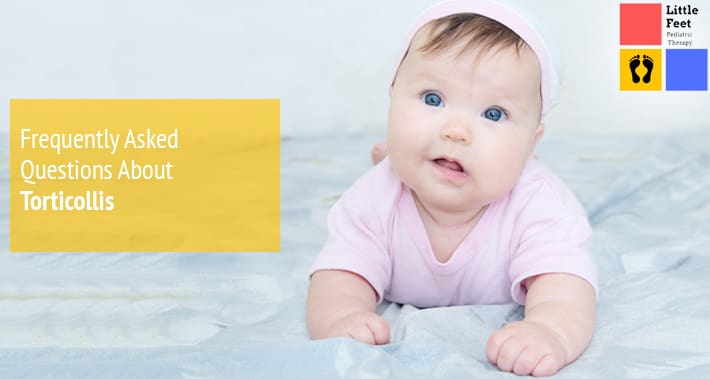
Torticollis is a condition characterized by having a tilted head, or being unable to turn your neck evenly.
Babies develop torticollis most commonly in utero or at birth.
Occasionally, though, sometimes they will develop torticollis shortly after birth, as they grow.
Torticollis can be the most serious at birth or shortly after birth, because if left untreated, it can affect your child’s development.
But don’t worry.
The most common type in newborns is congenital muscular torticollis, which can be corrected with pediatric physical therapy for torticollis.
Your local pediatric therapy clinic is a good resource to consult if you’re not sure if your baby has torticollis.
That’s because pediatric physical therapists are experts at noticing, and correcting, abnormal movement patterns in your child.
They can also teach you how to promote optimal growth and prevent certain conditions with good parenting techniques.
Here at Little Feet Pediatric Therapy, we have four different pediatric therapy locations to serve you best.
If you’re in Washington DC, Charlotte NC, Raleigh NC, or St. Louis MO, we can help your child.
But in the meantime, let’s take a closer look at some frequently asked questions about torticollis.
What Is Torticollis?
Your sternocleidomastoid muscles, or SCM for short, are a pair of muscles in your neck.
They connect your sternum, your clavicle (collarbone), and your mastoid process, at the base of your skull.
To see them, take a moment to look in the mirror.
Then turn your head to the side.
That band that stretches from behind your ear to the top of your sternum (the spot where your neck becomes your chest) is one of your SCM muscles.
Turn your head the other way to see the other one.
These muscles are responsible for most of the movements of your neck.
With torticollis, your baby’s SCM muscle shortens and causes their neck to twist to one side.
That’s why torticollis can also be called wry neck, because it refers to your baby’s twisted or tilted neck.
Contracting the muscle causes their head to tilt towards the side and rotate away from the affected muscle.
This condition can be painful, but usually is not.
However, it does cause movement restriction.
How Do I Tell If My Baby Has Torticollis?
There are some particular symptoms to watch out for if you’re concerned your baby might have torticollis.
A common symptom is that your baby won’t be able to turn their head equally in both directions without assistance.
You might also notice that your baby tends to tilt their head to one side often.
An easy way to examine this as a parent is to look at pictures of your child.
Do they seem to always have their head tilted to one side?
If so, they might have torticollis.
Some other signs to watch for include:
- One hand dominating fine motor skills development more than usual
- Rolling only to one side
- Uneven neck mobility when watching toys or looking for you
- Lifting their head to only one side during tummy time
- Having a tilted head while sitting or standing
- A flat spot on one side of their head (plagiocephaly)
- A bulging of their skull over their eyelid
Babies with torticollis are also more likely to have tongue tie.
Tongue tie is a condition where the part of a baby’s tongue that connects with the bottom of their mouth – called the frenulum – is shorter, thicker, or tighter than usual.
We don’t yet know exactly how these two disorders are related, however.

Is Torticollis A Hereditary Condition?
Torticollis is not always a hereditary condition, bit it can be.
However, this is rare.
Your baby can develop torticollis at birth or in utero, which is why it is called congenital.
It can also develop as your baby grows, or be acquired after an injury or infection.
There are two main causes of the condition that determine the type of treatment that can help.
The first is a bone problem, and the second isn’t – it can be neurologic, myofascial, or muscular.
If your child’s torticollis is caused by a bone problem, like a congenital vertebral anomaly, they may need corrective surgery.
Be sure to consult your primary healthcare provider.
On the other hand are neurologic, myofascial and muscular causes of torticollis.
These can be addressed with less invasive treatment options, often by a physical therapist.
Pediatric physical therapists often have lots of experience helping children with torticollis.
This is because the most common cause of torticollis in children is congenital muscular torticollis – one of the types physical therapy can help with.
Is Torticollis Permanent?
Torticollis can last anywhere from a few months to being a permanent condition.
It depends on the underlying cause.
As we mentioned previously, it can be caused by a bone problem, or a soft tissue problem.
Bone problems are congenital, harder to resolve, and increase the chances of the condition being permanent without surgery.
If your baby’s torticollis is caused by a soft tissue problem, however, then it can sometimes resolve within a few weeks with physical therapy and a home program.
Is Torticollis Life Threatening?
In most cases, no, torticollis is not life threatening.
Rather, when your child is not able to change their neck position, one side can get tight and cause movement challenges.
Does Torticollis Go Away On Its Own?
Torticollis can go away on its own, but typically does not and is best if treated early.
The earlier you begin physical therapy, the shorter you’re your baby will typically spend in physical therapy.
As well, the less chance of lingering movement imbalances as your child gets older.
Can Torticollis Cause Developmental Delays?
Yes, torticollis can cause developmental delays, but only if it’s left untreated.
Torticollis may impact your child’s ability to roll, crawl, and even walk.
This is because when the neck is tight and tilted to one side due to muscle restrictions, the fascia, the thin layer of connective tissue between the skin and the muscle is usually the culprit.
When there is a noticeable restriction in the fascia at your child’s neck, causing the head to tilt to one side, the fascia is typically restricted throughout that same side of their body.
This means that their shoulders, trunk, and hips can also have restrictions making it difficult to move and meet developmental milestones.
If you notice your baby has the signs of torticollis, it’s a good idea to get them treated as soon as possible.
The sooner you address it in your child, the less chance for any long term complications.
Can Torticollis Affect Your Baby’s Vision?
Over time, if left untreated, torticollis can affect your baby’s vision.
This is because it can limit your child’s visual development by limiting their visual tracking and impairing their depth perception.
But, it goes both ways.
Problems with vision can also cause torticollis.
The important thing to do if you suspect your child may have torticollis or vision problems, is to have them evaluated as soon as you suspect there might be a problem.
How Can You Prevent Torticollis?
The good news is that you can prevent torticollis, depending on the cause, with early identification.
If it’s congenital muscular torticollis, your baby’s physical therapist can target your baby’s specific muscles that need to be stretched and strengthened.
The goal is to loosen tight muscles and tendons, which will allow your baby’s head to tilt back into a neutral position and allow for full range of motion.
They will also provide you with a take home program to continue strengthening your child’s neck and tips to reduce the chances of reoccurrence.
Some examples of these take home exercises include increasing your baby’s time awake on their belly, known as tummy time, changing the setup of how they sleep or eat, and ways to play with your baby that encourage stretching and strengthening.
Your child’s physical therapist might also recommend that you help your child change position throughout the day frequently.
What To Do If Your Baby Has Torticollis
If you’re concerned that your baby has torticollis, you should have them evaluated by a pediatric physical therapist to determine the cause of the condition.
At Little Feed Pediatric Therapy, we provide a tailored approach to physical therapy.
After identifying the cause of your child’s symptoms, we’ll develop a treatment plan to help your child’s neck return to its optimum resting position.
We’ll also help with preventative exercises to help ensure that your child safely meets their developmental milestones.
Book your appointment with Little Feet Pediatric Therapy today.
► 3535 Randolph Rd, Charlotte, NC 28211
► 1331 H St NW Ste 200, Washington, DC 20005
► St. Louis, MO
► Raleigh, NC
Founded in 2019, Little Feet Therapy offers on site pediatric physical and occupational therapy treatments for children from 2 months to 18 years old with physical and developmental concerns. Our clinics focus on providing therapy in a child’s natural setting where your child is in familiar surroundings, it puts their mind at ease and helps them focus more on the work they’re doing with their pediatric therapist. Our therapists will work with your child at your home, at school, at daycare, or another place in the community where they feel most comfortable.